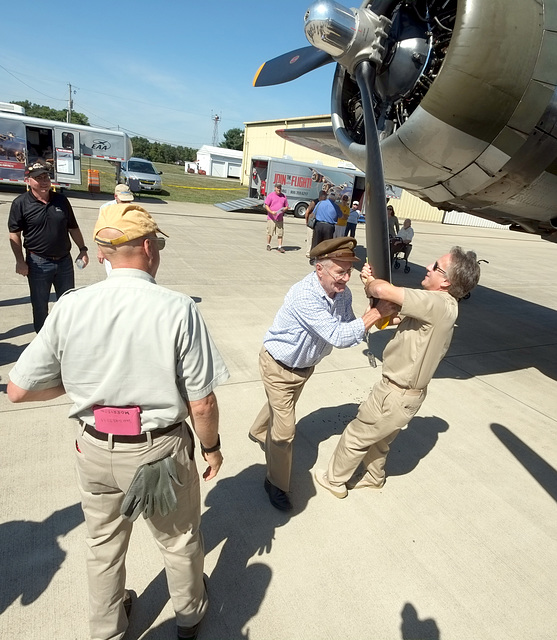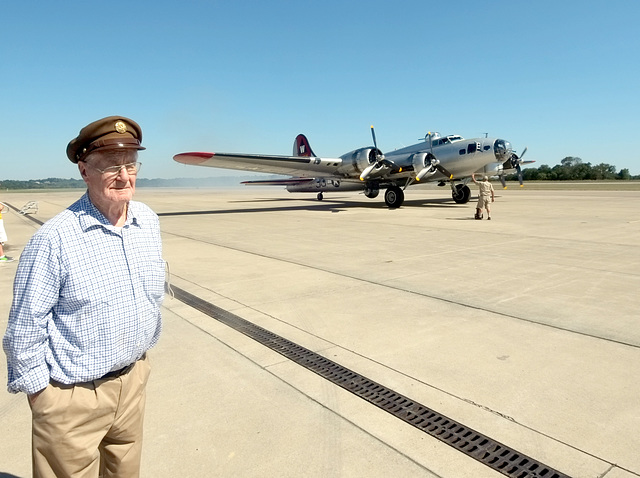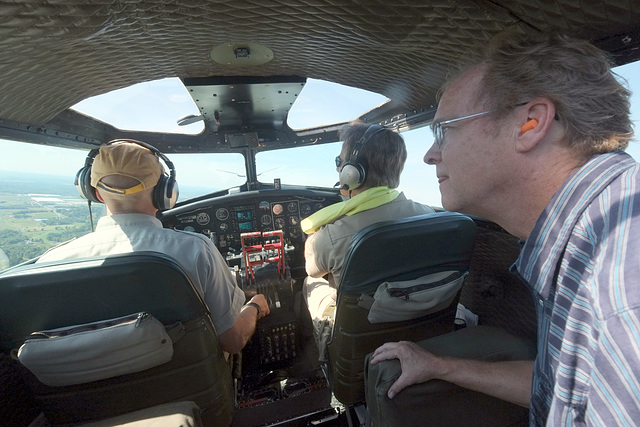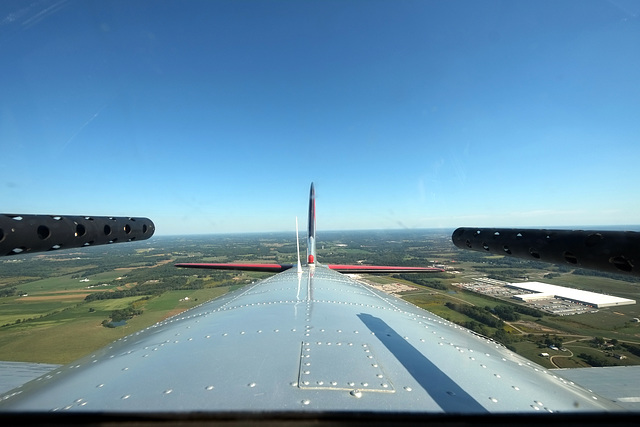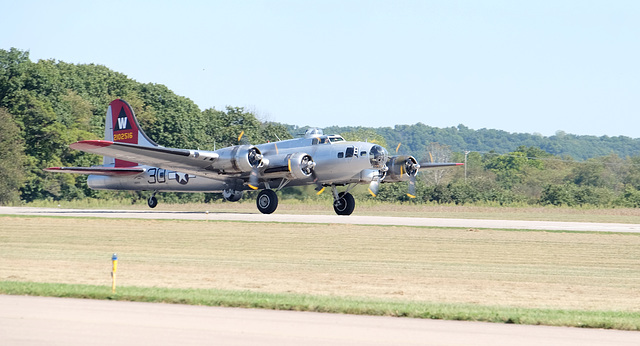
Flying the B-17 "Aluminum Overcast"
If you like airplanes, you owe a debt to the Experimental Aircraft Association, headquartered in Oshkosh, Wisconsin. In addition to its support of new kinds of airplanes and thoase who fly old kinds of airplanes, the EAA itself has restored and maintains a collection of flightworthy -- and flying -- historical aircraft. Among them is "Aluminum Overcast," the EAA's B-17 bomber, a mainstay in the al…
(read more)
22 Sep 2016
One of the most famous planes of the European Theatre
The Experimental Aircraft Association's B-17 "Aluminum Overcast" waits on the ramp at the Zanesville, Ohio, airport. The fuly restored World War II bomber's name stems from the saying that the skies over Germany would become black with allied bombers -- the B-17 chief among them.
22 Sep 2016
Then and now, come together
A unique meeting: WWII B-17 flight engineer and top turret gunner Frank Girman and EAA B-17 pilot Tom Ewing rotate one of the plane's four engines. The radial engines tended to allow oil to pool in the cylinders, causing catastrophic engine trouble if undetected. So before flight each engine must be turned by hand, seven revolutions. It's not an easy task, and if oil has gotten into a cylinder it becomes impossible until a crewman removes the spark plug and allows the oil to drain.
22 Sep 2016
He's heard that sound before
With the B-17 "Aluminum Overcast" firing up in the background, 93-year-old Frank Girman of Brunswick, Ohio, poses for a picture. He was flight engineer and top turret gunner on 35 B-17 missions over Germany in World War II. Part of the 546th Squadron of the 384th Bomb Group of the 8th Army Air Force, he flew out of Northamptonshire, England.
22 Sep 2016
Soon it will roll to the runway
Frank Girman, 93, turns to watch the four radial engines on the antique bomber come to life. Until this day, he hadn't been on a B-17 for more than 70 years. When he did fly in them, his 35 missions included Normandy, the attacks on the Ruhr Valler, Operation Market Garden, and the Battle of the Bulge.
22 Sep 2016
A view from the air
Taking a look from the seat right behind the cockpit is Athens News Editor and Publisher Terry Smith.
22 Sep 2016
Most of those who've had this view have now passed on
A view of the plane's port wing and engines from the navigator's station. The Zanesville flight was on a 90-degree, clear day, with a bit of turbulance caused by the heating of air at different rates over different patches of ground -- the same thing that causes buzzards to circle in some areas to catch updrafts.
22 Sep 2016
No Messerschmitts or Focke-Wulfs in sight
This is what the top turret gunner would see, a .50-caliber machine gun on each side. Flight engineer and top turret gunner Frank Girman said during his 35 missions he fired at two German fighters. "I didn't hit them -- well, they kept flying, so I guess I didn't," he said. "The guns jumped around, but that was a good thing, it was like a big shotgun."
22 Sep 2016
The takeoff roll, tail wheel up
The B-17 lumbers -- that's the right word -- down the runway in Zanesville. Bombers were dump trucks compared to fighter planes' sports cars. Climbing at 300 feet per minute, the B-17 would typically cross the German border at 25,000 feet.
22 Sep 2016
Pretty, isn't it
Majestic looking now, this silhouette once sparked terror in Axis industrial and military installations. They would come in waves, hundreds of planes at a time, "turning the sky black with bombers," as the saying went. Early in its career, the B-17 had to fend for itself against the Luftwaffe's fighter pilots, but by mid-war long-range allied fighters such as the North American P-51 Mustang would fly cover and keep the fighters busy. But nothing could distract the flak -- essentially fragmentation grenades that exploded near the bombers.
Jump to top
RSS feed- Latest items - Subscribe to the latest items added to this album
- ipernity © 2007-2024
- Help & Contact
|
Club news
|
About ipernity
|
History |
ipernity Club & Prices |
Guide of good conduct
Donate | Group guidelines | Privacy policy | Terms of use | Statutes | In memoria -
Facebook
Twitter



